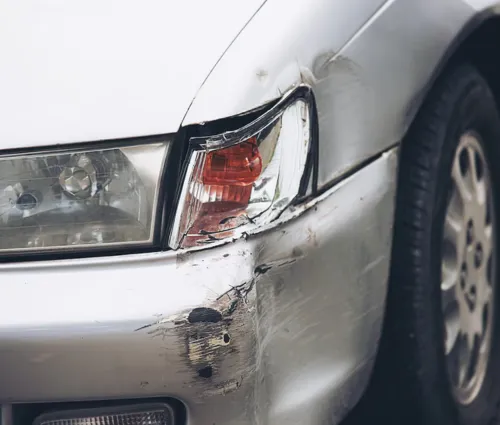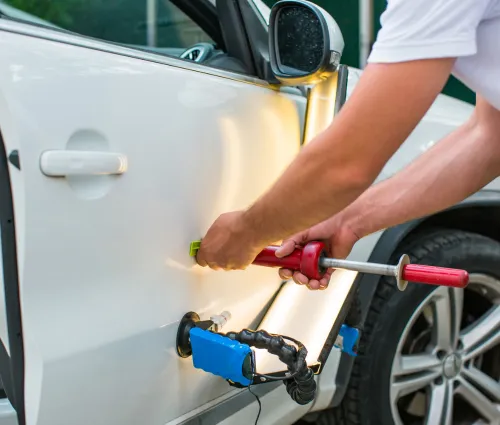PDR Best Practices
Weather and Paintless Dent Repair: Getting It Right

FSDAVCFEBFEVSDDVFSD

FSDAVCFEBFEVSDDVFSD

FSDAVCFEBFEVSDDVFSD
Why shop climate control changes PDR outcomes

Paintless dent repair is precise metalwork, and the environment around the vehicle matters more than most people realize. Stable temperature and managed humidity help technicians read metal, control glue-pull adhesion, and avoid texture changes. At Dentex Midwest, we tune the bay so the panel behaves predictably, not reactively.
Climate control also protects the factory finish. Cold panels resist movement and can create micro-highs when pushed too quickly, while overheated skins soften paint and upset clearcoat texture. By keeping conditions in range before tools ever touch metal, we reduce risk and increase quality from the first pull.

Panel temperature: the sweet spot for PDR
Metal moves best when the panel is warm, not hot. In practice, that usually means ambient shop temps in the mid 70s F and panel temps near the same. At that level, crowns relax, lows respond, and pushes seat smoothly under a tap-down. Too cold and metal rebounds; too hot and paint becomes fragile.
Cold push risks include cracked clear, springback, and tool marks that refuse to settle. When panels arrive near freezing after winter driving, we stage the vehicle in a warm bay and preheat with soft heat, never open flame. Even, gradual warming prevents shock lines and lets our reading light show true reflection.
Overheated panels create different problems. Clearcoat can imprint, waxes smear, and the substrate becomes gummy, masking highs and lows. We track surface temperature with infrared thermometers, adjust heat guns or lamps accordingly, and pause when readings creep upward. The goal is consistency: warm enough for controlled metal flow, cool enough to protect finish, adhesive, and surrounding trim, through the entire repair process from start safely.

Humidity and glue-pull: curing that counts
Glue pulling depends on chemistry as much as technique. High humidity slows solvent flash, lengthens set time, and can allow tabs to drift before force loads, reducing lift. Extremely dry air can make adhesives brittle, increasing shear and causing premature release. We watch the hygrometer and match adhesive type, tack, and dwell time to the day’s conditions.
For storm season hail, we often lean on medium-tack formulations that cure reliably between forty and sixty percent relative humidity. When dew points spike, we shorten dwell, increase tab surface prep, and use fresh alcohol for cleaner releases. In dry winter air, we extend dwell slightly and avoid overcooling panels, which can harden glue and shock the surface. We select tab sizes carefully to maintain balance too.

Dentex Midwest outfits each bay for repeatable climate control. Overhead LED lighting and movable PDR lights reveal distortion, while thermostatic heaters warm space evenly. We use heat guns and panel-safe lamps for localized warmth, gauged with infrared thermometers so we know the surface, not just the air, is ready. Dehumidifiers and filtered airflow keep relative humidity stable and prevent dust from imprinting softened clear.
Our setup also includes insulated doors, sealed floor drains, and curtainable work zones to isolate vehicles during glue pulls. Hygrometers are visible from the stand so the tech can adjust dwell without breaking stance. We rotate glue sticks seasonally, store tabs in clean cases, and replace alcohol frequently to avoid contamination. Small habits compound: Dentex Midwest environment control means fewer pull marks, cleaner releases, and faster finishing time under cross-light. Technicians log readings at start, midpoint, and final inspection for consistent results everywhere.
Avoiding cold push and overheated mistakes
A cold panel is spring steel in disguise. Pushing dents when metal is below comfort range invites elastic rebound, shadowing, and tool tracking that will not blend. We precondition with gentle heat until the reflection stops shivering, then reset panel supports. The result is smoother lifts that sit down with fewer taps and less overstretch and strain.
Heat can also go too far. When a panel is overheated, clear becomes tender, adhesive footprints smear, and orange peel can change around the repair. Our standard is warm, uniform, and measured. If infrared readings climb, we back off, ventilate, and allow a short cool-down before continuing so texture stays consistent under different lighting angles and conditions.
Between those extremes lies quality. We stage panels, adjust lamps, and confirm with a quick fingertip test beside the thermometer reading. If the metal feels alive—not hesitant, not mushy—we proceed. That simple feedback loop, plus controlled humidity, supports accurate pushes, cleaner pulls, and finish-friendly blending that protects the factory look for the long haul in every season.
Seasonal tips for Missouri vehicle owners
Winter: allow warm-up time. Snowmelt leaves panels cold and damp; wiping dry isn’t enough. A warm bay and gradual heat restore metal response and protect clear. Morning drop-offs let the car acclimate before estimates or glue-pull testing.
Summer: avoid baking panels. Midday sun can push surfaces past safe range, softening paint and skewing reflections. Park in shade, skip the pre-visit carwash, and expect cool-downs between pulls. Consistent, moderate heat speeds progress and preserves texture during finish work.
Storm season: document dents and book early. Moisture can hide in seams; keeping the vehicle dry helps glue perform. We’ll advise on timing so the car reaches our climate-controlled bay ready for accurate estimates and efficient repair.


Quality assurance starts before the first push and ends after final polish. We verify panel temperature with infrared thermometers, confirm humidity readings, and log both on the work order. Under cross-light, we check for micro-highs, crowns, and pull marks, then tap and re-verify reflection. A short alcohol wipe shows texture truth before the vehicle moves bays. Only when the panel looks neutral from multiple angles do we sign off and schedule delivery or downstream paintwork as needed.
Inside our controlled repair workflow
Intake begins with a walkaround, photos, and measurement of panel and ambient conditions. We note temperature and relative humidity, then move the car to a bay matched to the job. For hail, we plan glue-pull sequences, panel access, and staging pads. For door dings, we choose push points, bumpers, and heat approach. Everything centers on predictable, repeatable conditions before metal is touched. Technicians verify tools, tabs, and alcohol freshness too.
During repairs, technicians maintain temperature with controlled lamps and confirm with touch and thermometer. We adapt adhesive selection to current humidity and panel coating, using smaller tabs on tight ridges and larger tabs to lift broad lows. Between pulls, we cool, level, and read the reflection under multiple lights so the metal tells the next move. If readings drift, we pause, reset airflow, and retest before continuing for consistent quality.
Before delivery, we complete a final environment check, then a multi-angle inspection in shaded light and daylight. We confirm there are no micro-highs, no adhesive marks, and the texture flows naturally into surrounding panels. Photos and logged readings attach to the job file, documenting the controlled process behind the finish you see. That way your estimate, repair, and result align with what the environment supported at every step all along.

Dentex Midwest
Professional Hail Repair & PDR
Stay Up-to-date With Our Content
Subscribe to learn more about our mission!
Stay Up-to-date With Our Content
Subscribe to learn more!
Contact Info
Service Hours
Social Media
Home
Services
Service Areas
Blog
About
Contact
Contact Info
Service Hours
Mon - Fri: 8:00 am – 6:00 pm
Saturday: by Appointment
Sunday: Closed
Social Media

Licensed, bonded, & insured